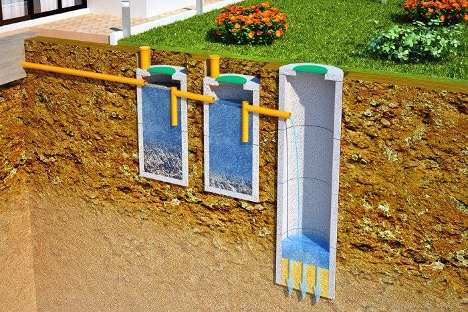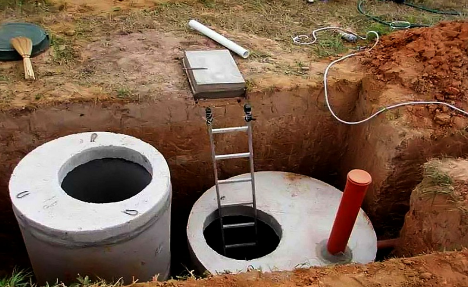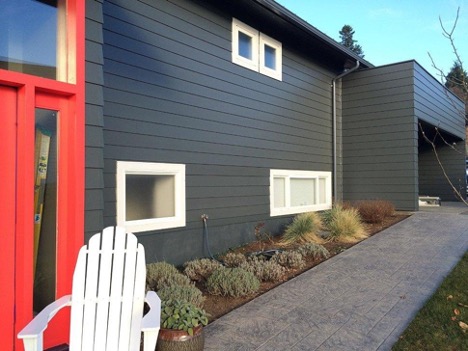A septic tank for a bathhouse without pumping: how to make it yourself from tires and concrete rings
A sauna septic tank without pumping plays a key role in providing an environmentally friendly and cost-effective wastewater disposal system. The main goal of such a system is to minimize the impact on the environment. You also need to eliminate the need for regular maintenance associated with pumping out waste. An effectively functioning septic tank allows for biological wastewater treatment. The purified water is then naturally filtered into the soil without harming the ecosystem.
In addition to the environmental component, a septic tank for a bathhouse without pumping has significant economic advantages. The one-time costs of installing such a system are recouped due to the absence of the need for regular paid pumping and maintenance. This makes it an ideal solution for remote or suburban households. Also, creating a septic tank yourself from available materials, such as tires or concrete rings, further reduces the financial costs of installing a sewer system.
Using a septic tank without pumping for a bathhouse improves the quality of life. It also provides autonomy and comfort of living without constant concern about the condition of the sewer system. Thus, choosing this type of septic tank becomes not only a profitable decision. After all, this is a contribution to the conservation of nature.

The content of the article
Advantages of a septic tank made from bathhouse tires and concrete rings
A sauna septic tank, especially the tire and concrete ring versions, offers a number of advantages that make it the optimal choice for wastewater treatment. A septic tank for a bathhouse without pumping out tires is an environmentally friendly and cost-effective solution. Tires, due to their porous structure, provide natural filtration and aeration of wastewater. This promotes the activation of biological processes of decomposition of contaminants. This septic tank is easy to install with your own hands. And it does not require significant costs. After all, the main material is used car tires.
A septic tank made from concrete bath rings offers improved strength and durability. Concrete rings provide reliable isolation of wastewater from the soil. They also prevent pollution and contamination of groundwater. This is especially important for bathhouses with toilets, where the volume of wastewater is much higher. A septic tank for a bathhouse with a toilet, made of concrete rings, can withstand heavy loads. It can also provide effective cleaning for many years.
Thus, both septic tank options offer their own unique advantages:
- environmental friendliness and accessibility for tires;
- strength and durability for concrete rings.
The choice of a specific type depends on individual preferences, wastewater volume and specific conditions.
How to properly plan a septic tank for a bathhouse
Proper planning of a sauna septic tank is a key aspect to ensuring an effective and safe wastewater disposal system. During the planning process, it is necessary to take into account a number of important points so that the septic tank lasts a long time and does not require frequent maintenance.
The first step in planning is choosing a suitable location for the septic tank. It must be located at a distance of at least 5 meters from the bathhouse. This will help prevent odors and waste water from entering the room. It is also important to consider groundwater. The septic tank should be at least 1-2 meters above their level. This way you can avoid contamination.
The choice between a septic tank made of tires and concrete rings depends on personal preferences, budget and operating conditions. A tire septic tank is more economical and easier to install, but may require more material for a large volume of wastewater. Concrete rings provide greater strength and durability. But their installation requires specialized equipment and additional costs.
The size of the septic tank must correspond to the amount of wastewater produced by the bathhouse. As a rule, a septic tank with a volume of 1 to 3 cubic meters is sufficient for an average bath. The design of the septic tank may vary depending on the type. But it usually includes several chambers for primary treatment and filtration of wastewater.
An effective drainage and filtration system is critical for a bathhouse septic tank. It provides additional treatment of wastewater before it is returned to the soil. Using gravel, crushed stone and sand in the drainage system helps improve filtration and prevent clogging.
When planning and installing a septic tank, it is important to follow all local building codes regarding wastewater disposal. This will help avoid problems with the law and ensure safe operation of the system.
Careful planning of a septic tank for a bathhouse will allow you to create a reliable and effective wastewater treatment system that will serve for many years without the need for frequent pumping and additional maintenance.

Step-by-step instructions: creating a septic tank for a bathhouse with your own hands
Creating a septic tank for a bathhouse with your own hands requires careful planning and execution of each stage of the work. Here are step-by-step instructions to help you through this process:
- Determine the volume of wastewater that your bathhouse will produce to understand the size of the required septic tank.
- Make sure that the location for the septic tank is at a safe distance from the bathhouse, water sources and trees. The recommended distance is at least 5 meters from the bathhouse.
- The size of the pit should match the size of your septic tank. For a septic tank made of tires, the depth can be about 1.5-2 meters, and for a septic tank made of concrete rings - in accordance with their sizes.
- Dig a pit taking into account all dimensions. The walls and bottom of the pit must be smooth.
- Place the first tire at the bottom of the pit and fill it with sand or gravel for stability. Continue laying down the tires, filling each one with sand or gravel.
- Install the first concrete ring at the bottom of the pit. If necessary, use sealant between the rings to prevent leaks.
- Place a layer of crushed stone or coarse gravel at the bottom of the pit, then a layer of sand. This will serve as the primary filter for treating wastewater.
- Lay drainage pipes on a layer of sand to drain purified water. The pipes should have a slight slope for better water drainage.
- Fill the pit with soil, leaving access to the top of the septic tank for maintenance.
- Test the system by filling the septic tank with water and checking how it filters and leaves through the drainage pipes. Make sure there are no leaks and the water is well filtered.
Creating a septic tank for a bathhouse with your own hands takes time and labor, but the result pays off with a reliable and environmentally friendly wastewater disposal system. It is important to carefully follow all the steps and not neglect the quality of materials and work so that the septic tank will serve for many years.
Arrangement and operation: care of a septic tank for a bathhouse without pumping
The installation and subsequent operation of a septic tank for a bathhouse without pumping requires a careful approach and regular maintenance for the system to function efficiently and long-lastingly. Proper septic tank care includes several key aspects that will help prevent potential problems and ensure reliable operation of the system.
The first step after installing a septic tank is its proper operation. Avoid introducing large objects, chemicals, or other substances into the septic tank that could disrupt the system or cause it to clog. Regularly check the level of sediment accumulation in the chambers of the septic tank and, if necessary, remove it to prevent overflow and wastewater from escaping to the surface.
An important component of septic tank care is monitoring the condition of the drainage field. Make sure drainage pipes are not blocked and water flows freely into the soil.Signs of problems may include standing water on the surface of the ground or a foul odor in the area of the septic tank.
It is also recommended to periodically add special biological products to the septic tank, which promote more efficient decomposition of organic substances and reduce the likelihood of clogging. These drugs help maintain the balance of microorganisms in the system and provide better wastewater treatment.
By following these simple recommendations, you can ensure long-lasting and efficient operation of your bathhouse septic tank without pumping, avoid additional costs for its maintenance and contribute to preserving the environment.



